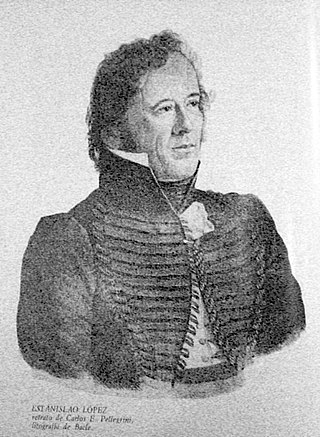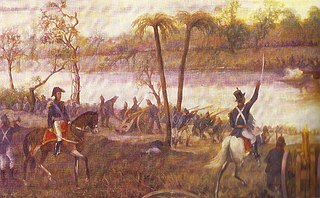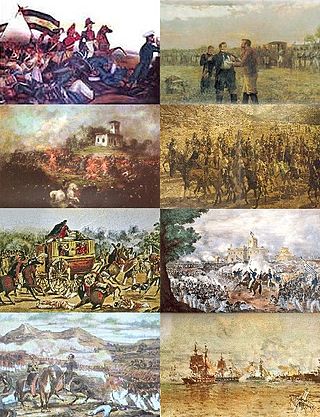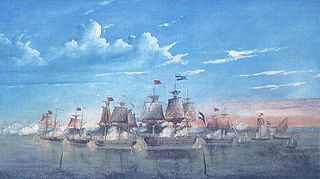
The Argentine Confederation was the last predecessor state of modern Argentina; its name is still one of the official names of the country according to the Argentine Constitution, Article 35. It was the name of the country from 1831 to 1852, when the provinces were organized as a confederation without a head of state. The governor of Buenos Aires Province managed foreign relations during this time. Under his rule, the Argentine Confederation resisted attacks by Brazil, Bolivia, Uruguay, France and the United Kingdom, as well as other Argentine factions during the Argentine Civil Wars.

José Gervasio Artigas Arnal was a soldier and statesman who is regarded as a national hero in Uruguay and the father of Uruguayan nationhood.

The Argentine War of Independence was a secessionist civil war fought from 1810 to 1818 by Argentine patriotic forces under Manuel Belgrano, Juan José Castelli, and José de San Martín against royalist forces loyal to the Spanish crown. On 9 July 1816, an assembly met in San Miguel de Tucumán, declaring independence with provisions for a national constitution.

The Battle of San Lorenzo was fought on 3 February 1813 in San Lorenzo, Argentina, then part of the United Provinces of the Río de la Plata. The royalist troops, were composed of militiamen recruited in Montevideo under the command of militia captain Antonio Zabala that was defeated by the Regiment of Mounted Grenadiers, under the command of José de San Martín. This battle was the baptism by fire for this military unit, and for San Martín in the Spanish American wars of independence.

Estanislao López was a caudillo and governor of the province of Santa Fe, Argentina, between 1818 and 1838, one of the foremost proponents of provincial federalism, and an associate of Juan Manuel de Rosas during the Argentine Civil War. He is considered an iconic figure in Santa Fe and one of the most influential political actors in the Argentine conflicts of the 1820s and 1830s.

In the Paraguayan War, the Battle of Yatay was fought on August 17, 1865, between the troops of the Triple Alliance and the soldiers of Paraguay near Paso de los Libres, Corrientes, Argentina.

Brigadier General José María Paz y Haedo was an Argentine military figure, notable in the Argentine War of Independence and the Argentine Civil Wars.
The Battle of Cepeda of 1820 took place on February 1 in Cañada de Cepeda, Buenos Aires Province, Argentina. The conflict was the first major battle that saw Unitarians and Federals as two constituted sides. It ended with the defeat of the national government.

The Treaty of Pilar was a pact signed among the rulers of the Argentine provinces of Santa Fe, Entre Ríos and Buenos Aires, which is recognized as the foundation of the federal organization of the country. It was signed in the city of Pilar, Buenos Aires on 23 February 1820 by governor Estanislao López for Santa Fe, caudillo Francisco Ramírez for Entre Ríos, and provisional governor Manuel de Sarratea for Buenos Aires, after the dissolution of the national government caused by the Battle of Cepeda. A reference to it was included in the Preamble of the Argentine Constitution of 1853 as one of the "pre-existing pacts" fulfilled by it.

The Federal League, also known as the League of the Free Peoples, was an alliance of provinces in what is now Uruguay, Argentina and Brazil that aimed to establish a confederal organization for the state that was emerging from the May Revolution in the war of independence against the Spanish Empire.

The Paraguay campaign (1810–11) of the Argentine War of Independence was the attempt by a Buenos Aires-sponsored militia, commanded by Manuel Belgrano, to win the royalist Intendency of Paraguay for the cause of May Revolution. In Paraguay it is considered as their War of Independence.
The Battle of Tacuarí was a battle in Southern Paraguay between revolutionary forces under the command of General Manuel Belgrano, member of the Primera Junta government of Argentina, and Paraguayan troops under colonel Manuel Atanasio Cabañas, at the time at the service of the royalists.

The Platine War was fought between the Argentine Confederation and an alliance consisting of the Empire of Brazil, Uruguay, and the Argentine provinces of Entre Ríos and Corrientes, with the participation of the Republic of Paraguay as Brazil's co-belligerent and ally. The war was part of a decades-long dispute between Argentina and Brazil for influence over Uruguay and Paraguay, and hegemony over the Platine region. The conflict took place in Uruguay and northeastern Argentina, and on the Río de la Plata. Uruguay's internal troubles, including the longrunning Uruguayan Civil War, were heavily influential factors leading to the Platine War.
Francisco Javier de Viana (1764–1820) was an Argentine sailor and soldier who actively participated in the politics of his country as an ally of general Carlos María de Alvear.

The Argentine Civil Wars were a series of civil conflicts of varying intensity that took place through the territories of Argentina from 1814 to 1853. Beginning concurrently with the Argentine War of Independence (1810–1820), the conflict prevented the formation of a stable governing body until the signing of the Argentine Constitution of 1853, followed by low-frequency skirmishes that ended with the Federalization of Buenos Aires. The period saw heavy intervention from the Brazilian Empire that fought against state and provinces in multiple wars. Breakaway nations, former territories of the viceroyalty, such as the Banda Oriental, Paraguay and the Alto Peru were involved to varying degrees. Foreign powers such as the British and French empires put heavy pressure on the fledgling nations at times of international war.

Francisco Ramírez, also known as "Pancho" Ramírez as well as "El Supremo Entrerriano" (1786–1821), was an Argentine governor of Entre Ríos during the Argentine War of Independence.

The Battle of Martín García was fought from 10 to 15 March 1814 between the forces of the United Provinces of the Río de la Plata under the command of then-Lieutenant Colonel Guillermo Brown, and the royalist forces commanded by frigate captain Jacinto de Romarate, defending the region.
The Battle of Caaguazú took place in Mercedes Department, in Corrientes Province, Argentina on 28 November 1841, during the Argentine Civil War, between the forces of Entre Ríos Province, commanded by brigadier Pascual Echagüe and Corrientes Province, under brigadier José María Paz, with a sound defeat of the Federal Party forces of Entre Ríos.

The Anglo-French blockade of the Río de la Plata or also known as War Of Parana was a five-year-long naval blockade imposed by France and Britain on the Argentine Confederation ruled by Juan Manuel de Rosas. It was imposed in 1845 to support the Colorado Party in the Uruguayan Civil War and closed Buenos Aires to naval commerce. The Anglo-French navy trespassed into Argentina's internal waters to sell their products, as Rosas maintained a protectionist policy to improve the weak Argentine economy. Eventually both Britain and France gave in, signing treaties in 1849 (Britain) and 1850 (France) acknowledging the Argentine sovereignty over its rivers.

The Corrientes campaign or the Paraguayan invasion of Corrientes was the second campaign of the Paraguayan War. Paraguayan forces occupied the Argentinian city of Corrientes and other towns in Corrientes province. The campaign occurred at the same time as the Siege of Uruguaiana.















